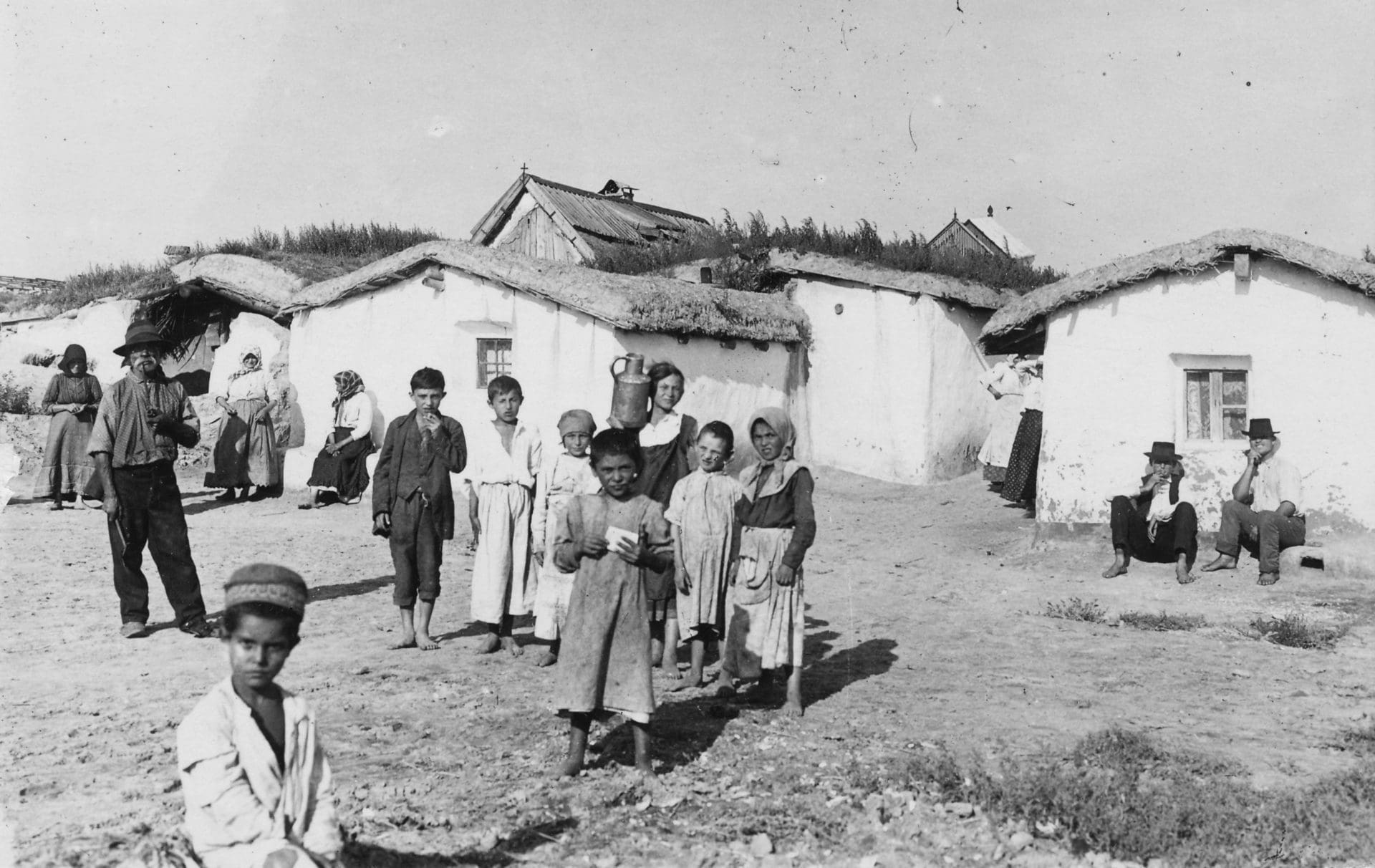Although there is an extensive literature on the anti-Semitism of the interwar period, the situation of the Romani (or Gypsies) during the Horthy era used to raise the interest of few researchers. The situation of the Gypsies in this period ranged from tolerance and jovial disdain to exclusion, which literary historian János Hankiss characterized a quarter of a century later by saying that the Gypsies were ‘relatable strangers’ in Hungarian culture: ‘A piece of the mysterious East, but not the Hungarian East.’[1]
The anti-Gypsy discourse tended to exaggerate the number of Gypsies, like all that of minorities. Different figures about the number of Gypsies circulated in contemporary sources. István Strausz, an independent parliamentary representative from Marcal, complained in 1925 that in his district ‘four or five thousand wandering gypsies are walking around […] endangering public safety’,[2] but it was an obvious exaggeration. During the Horthy era, most Gypsies lived in Baranya county in the south, but even there their number only reached a few thousand.[3] Around 7,000 Gypsies lived in the entire country in 1920.[4] However, when assessing the social situation of the Gypsies, historians struggle with a lack of resources. Unlike the Jews, the Gypsies were simply not interesting enough for the bureaucrats, instigators or neutral observers dealing with social affairs of the time due to their small number and poverty. It is not surprising that history books dealing with the issue sometimes skip decades due to a lack of sources. According to a 1918 state report, Gypsies lived in loam houses, while the prevalence of unemployment and lack of education were almost complete. According to a report from the beginning of the 1930s, the Gypsies of Ónod were poor and ‘unbelievably numerous’ and the phenomenon of petty crime was also highlighted.[5] However, the few sources from the period between the two reports do not give a different picture either.
The Gypsies were simply not interesting enough for the bureaucrats, instigators or neutral observers dealing with social affairs of the time
Relying on discursive sources, we would get an opposite picture of Gypsies in the early twenties. Although Gypsies had some jovial friends on the conservative side, Ferenc Herczeg described the gypsies in his memoirs as hard-working, farming, loyal Hungarian people[6], most nationalist sources—unsurprisingly—formulated collective judgments against the Gypsies. ‘An unruly, crime-prone, degenerate race from birth’,[7] wrote a fajvédő (‘racial preservationist’) magazine in 1921. ‘The wandering nomadic life has soaked into the blood of the Gypsies, and theft and robbery have become their second nature,’ said another paper.[8] At the same time, the fajvédő journal Cél explained that the Gypsy is just as undemanding as the Jew, ‘he puts a dung plaster on a bleeding wound, and eats an animal that died of anthrax without worry.’[9] The latter, apparently, was not always just a stereotype: Károly Kovárzik, chief inspector of animal health in Sopron, spoke about how Hungary is a ‘poultry graveyard’ because of animal diseases, but instead of destroying sick animals, rural people often sell them to Gypsies, who then ‘turn one carcass into ten and a hundred’. Kovárzik wanted to issue a warning to Gypsies not to eat sick animals as part of the settlement of the ‘Gypsy question’.[10] Racists probably thought of something very different when they spoke of the ‘Gypsy question’.
Kovárzik’s article is also worth mentioning because a politically unbiased author described a problem which was, according to him, very real. The question is whether the author tried to separate the stereotype from the description of real social situations. The question arises: did these prejudices only exist on the nationalist side? After all, in an early issue of the journal Nyugat, Ignotus (born Hugo Veigelsberg, a famous liberal Hungarian editor of Jewish ancestry) already argued in favour of resettling Gypsies in other territories, citing the example of the American Indians: as he wrote, if this ‘naughty’, ‘lazy’, ‘cunning’ yet ‘graceful’ people were forced to live communally , perhaps ‘[they would excel] not only in destruction, but also in creation. But if not, and if it were ruined and destroyed: at least we wouldn’t pay the price and it wouldn’t weigh on our souls’.[11] The socially sensitive poet of Jewish origin, György Sárközi, later referred to the biblical Cain when he described the eternal wandering and persecution of the Romani.[12] When István Lázár, a celebrated contemporary nationalistic author of Armenian origin, who published in various places from the fajvédő press to the liberal Világ, wrote a report about a Gypsy cottage in the mid-twenties, he probably felt that he had captured an unbiased impression in this way: ‘We enter the cottage. Devla [Roma word for God – ed.], what a hole! A bit of the East dwells in the brownish gloom’.[13]
The analysis of the discourse becomes even more exciting if we consider that some of the authors of the above criticisms were Jews, while the two minorities were regularly reviled together by the fajvédős. As early as the summer of 1921, the ébredő (that is, belonging to the Organisation of Awakening Hungarians) weekly, Hazánk clarified that ‘Hungary has to fight two internal enemies, and these two internal enemies are the Jews and the Gypsies’,[14] while Interior Minister Gedeon Ráday was convinced that in Transylvania, only the Jews and the Gypsies vote for Romanian candidates.[15] The views were not entirely new: Ferenc Blaskovich, abbot-canon of Temesvár (Timișoara, Romania today) explained as early as 1918 that ‘every race has characteristic good and bad qualities, except that the bad qualities are not as common and ingrained in any European race as they are in Jews and Gypsies’.[16]
However, the relationship between Romani and Jews was more complex than that. In the insulting of the Jewish cantor from Bicske, for example, local Gypsies took part in addition to ébredős,[17] which probably better signified the occasional cooperation of low-level social elements than anti-Semitism experienced among Romani, although some sources also indicate the latter.[18] However, when Romani desecrated the synagogue in the town of Izsák, which had been emptied due to pogroms, the Jewish magazine Múlt és Jövő urged the legislature to take action against the ‘terribly noisy’ and ‘obscene’ people, the ‘ilk of gypsies dwelling in tents’, whose activities it compared to Bolshevism.[19] Interestingly, right-wing author Cécile Tormay would have agreed with the association of Gypsies with the Left—with an anti-Semitic twist—as in her famous-infamous Bujdosó könyv (An Outlaw’s Book) she simply mentioned the song International as ‘Jewish-Gypsy’ music, obviously referring to the accusations of statelessness and alien nature shared by the two peoples.[20]
Similarly, the fetishization of women was also a common element in literature. The image of ‘brown Gypsy girls with fiery eyes’ also appeared in Lázár’s writings, and Győző Drozdy, a liberal politician who criticized the backward social position of the Romani in many places—often with well-meaning generalizations—once wrote a short story under a pseudonym, in which the first love of the teenage protagonist was a female member of a Gypsy caravan, a kind of ‘smoky Venus’.[21]
The sources consulted here do not indicate that the Romani were left-wing at any level. The socialist politician Sándor Csizmadia regularly visited the Gypsies of Orosház, who, according to him, enthusiastically read socialist papers[22]; however, this was probably an exaggeration, since most Romani were illiterate at the time. In the report quoted above, Lázár asked questions about the relationship between Gypsies and the 1919 communist coup d’état: ‘There was no “broletariat” on the Gypsy row here, because the grand voivod [Roma leader] kept order’ – came the reply.[23]
Accusations against Romani appeared primarily in the areas where Gypsies were really visible in society: music and public order
Accusations against Romani appeared primarily in the areas where Gypsies were really visible in society: music and public order. Some did not see Romani presence in these areas as problematic. In the mid-twenties, the well-informed head of the Hungarian Telegraphic Agency (MTI), Miklós Kozma believed that Gypsy music was ‘a very valuable, colourful characteristic [of the Hungarian nation]’.[24] However, even in the early twenties there were those who saw it differently. For example, the far-right pianist Ottmár Ságody wrote in his 1921 article that ‘Gypsy music’ was the work of the ‘destructive Gypsy race’, he; therefore, recommended that ‘we Hungarians should not entrust the cultivation of our national culture to a foreign race, but cultivate it by people of our own kind’.[25]
Perhaps the National Association of Gypsy Musicians wanted to respond to this, when they explained in a statement that ‘for centuries we have sympathized with Hungarians to the core, without exception we are Roman Catholics, we go to church, we observe the religious law and we have become Hungarians not only in name but in all our actions too. The word “destructive” cannot be applied to us, since the number of Gypsies who took their part in the loss of Hungarian blood on the battlefield is not one, but hundreds’.[26] The statement quoted patriotic Gypsies who were persecuted by the 1919 communist rule for their patriotism – and it would be hard not to notice how similar the text was to apologetics offered by Jewish authors, which—incidentally—amounted to little in the eyes of the antisemites. Hungarian actress Lujza Blaha (1850–1926) was one of the few who spoke out against anti-Romani discourse: the renowned actress invited Gypsy musicians to perform together.[27]
And where a question was discussed, solutions were also proposed. Gypsies who ‘pose a threat to public safety’ were listed on health registers as early as 1916 in view of the First World War,[28] but some people apparently wanted more. A significant part of the proposals, and almost all of the implemented decrees, concerned issues of public order. The Romani ‘are a terror to public safety’, ‘where the Gypies appear, the farm population, suspecting evil, lets loose the leashed dog and in many places they even ring the bell’ – so went an article from a rural newspaper in the fall of 1921, illustrating the atmosphere.[29]
Although according to the military counter-intelligence, ‘stray Gypsies’ regularly broke into apartments and farms in the countryside, this was undoubtedly an exaggeration.[30] However, the anecdote told by the smallholder politician Miklós Forgács from Zemplén, who was also the clerk of the National Assembly, described a real problem for the law enforcement agencies: namely that gendarmes could not fine Romani if they had no official name, address, known age or tax book.[31] In March 1921, an eight-year-old boy was kidnapped by Romani previously unknown to the authorities in Albertfalva, and the gendarmes were unable to catch the culprits.[32]
In October 1921, it was reported in the press that an internal affairs decree was being drawn up, which would enumerate the Romani based on fingerprints, would bind the movement of the Romani with a permit system, and their horses would also only be released with a permit.[33] The journal Új Nemzedék of Szeged asked the voivod of Tápa about the decree being prepared, who simply replied that he did not care.[34] In December 1921, citing public safety considerations, the General Assembly of Győr County sent a letter to the Ministry of the Interior, requesting ‘the internment of all Gypsies’ (!) and ‘the strictest procedure against the evasive race’.[35] Interestingly, the same thing was discussed by the general assembly in Komárom and Zala, but it was not adopted – arguing, in fact, that the Romani ‘cannot be changed by any means’.[36]
In the end, nothing came of these ideas, but there were examples of state violence. In Pestújhely, for example, detectives broke into the houses of Romani suspected of horse theft. The young people fled, but two older men – in fact, seventy years old! – Rafael József and Rafael István showed resistance with chairs. The two elderly men died during the procedure, according to the medical examination, due to ‘great mental excitement’.[37] It is up to the readers to decide whether they trust this official account of the story.
The Romani remained ‘undetected almost the entire time during the Horthy era, and during the Holocaust they were mainly affected by mass murders, not deportations. Few people thought of proactive and positive social assistance proposals. Much later, at the beginning of the forties, certain priests, such as the Greek Catholic priest Miklós Sója, carried out Romani missions on their own initiative, in the framework of which they also tried to improve the lives of the residents of the Gypsy row in Hodász through social work’.[38] However, this work, which Sója called a ‘Columbian task’, was an exception, and only a passing comment in bishop Ottokár Prohászka’s diary indicates that he also thought about evangelizing Romani.[39]
‘During the Holocaust they were mainly affected by mass murders, not deportations’.
[1] János Hankiss, A magyar irodalom Kelet és Nyugat között (Egyetemi Nyomda: Budapest, 1944), 81–82.
[2] Nemzetgyűlési napló, 29 (1922), 237.
[3] László Karsai, ‘A cigánykérdés Magyarországon, 1919–1945: út a cigány Holocausthoz’ (Cserépfalvi: Budapest, 1992), 22.
[4] Magyar Statisztikai Szemle, February-March (1987), 228.
[5] Barna Mezey (ed), A magyarországi cigánykérdés dokumentumokban, 1422–1985 (Kossuth Kiadó: Budapest, 1986), 161–162.
[6] Ferenc Herczeg, Herczeg Ferenc emlékezései, Vol. 1 (Singer és Wolfner: Budapest, 1939), 200–201.
[7] Hazánk, 24 July 1921.
[8] Szegedi Új Nemzedék, 15 October 1921.
[9] A Cél, April 1921.
[10] Köztelek, 17 September 1921.
[11] Nyugat, 1908/9.
[12] György Sárközi, Összes verse és kisebb műfordításai (Sarló: Budapest, 1947), 117.
[13] A Nép, 30 November 1924.
[14] Hazánk, 24 July 1921.
[15] Nemzetgyűlési napló, vol. 11. (1920), 557.
[16] Egyenlőség, 5 January 1918.
[17] Egyenlőség, 2 July 1921.
[18] See for example the case of the leader of a Romani musician band who told the government-aligned journal Magyar Helikon that eventually Gypsies would have to leave Hungary because there are too many Jews here. Magyar Helikon, 1921, 682. Much later, a liberal paper proposed that Gypsies come up with a sort of Zionism of their own and find their ancestral home in India. Insulted, a Zionist paper rejected the comparison. See Pesti Napló, 15 September 1935 and Zsidó Szemle, 20 September 1935.
[19] See the article ’Cigányok az izsáki zsidótemplomban’ [Gypsies in the synagogue of Izsák]. Múlt és Jövő, 29 July 1921, 1–2.
[20] Cécile Tormay, Bujdosó könyv (Lazi: Szeged, 2009), 265.
[21] Áron Eőry, ‘Be kell meszelni őket, mind fehér lesz!” Cigányemlítések intra muros. Cigányság-tematika a Horthy-korszak parlamentjében’, (2013). The article was previously available on the website of the IDEA Institute. I’d like to thank Áron Eőry for sharing his paper with me.
[22] Nemzetgyűlési napló, Vol. 5. (1920), 95.
[23] A Nép, 30 November 1924.
[24] Miklós Kozma, ‘Cikkek, nyilatkozatok 1921–1939’, (Budapest, n. p., 1939), 131.
[25] Magyar Helikon, (1921), 842.
[26] Hazánk, 24 July 1921.
[27] Hazánk, 26 September 1920.
[28] Nemzetgyűlési irományok, Vol. 5. (1922), 4.
[29] Szegedi Új Nemzedék, 15 October 1921.
[30] Hadtörténelmi Levéltár (Military Archives), HM ELN C 1920 106489.
[31] Nemzetgyűlési napló, Vol. 19. (1922), 121.
[32] Az Est, 17 March 1921.
[33] Bécsi Magyar Újság, 9 October 1921.
[34] Szegedi Új Nemzedék, 15 October 1921.
[35] Magyarság, 8 December 1921., and Új Nemzedék, 22 December 1921.
[36] Karsai, ’A cigánykérdés Magyarországon’, 47.
[37] Kis Újság, 8 February 1921.
[38] Éva Juhász, Sója Miklós öröksége Hodászon. (Szekszárd, n. p., 2004), 14–15.
[39] Ottokár Prohászka, Soliloquia (Szent István Társulat:Budapest, 1929), Vol. 2., 83.








